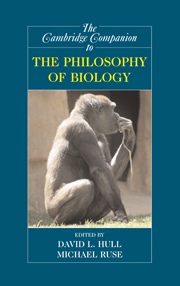Book contents
- Frontmatter
- 1 Adaptation
- 2 Population Genetics
- 3 Units and Levels of Selection
- 4 What’s Wrong with the Emergentist Statistical Interpretation of Natural Selection and Random Drift?
- 5 Gene
- 6 Information in Biology
- 7 Reductionism (and Antireductionism) in Biology
- 8 Mechanisms and Models
- 9 Teleology
- 10 Macroevolution, Minimalism, and the Radiation of the Animals
- 11 Philosophy and Phylogenetics: Historical and Current Connections
- 12 Human Evolution: The Three Grand Challenges of Human Biology
- 13 Varieties of Evolutionary Psychology
- 14 Neurobiology
- 15 Biological Explanations of Human Sexuality: The Genetic Basis of Sexual Orientation
- 16 Game Theory in Evolutionary Biology
- 17 What Is an ‘Embryo’ and How Do We Know?
- 18 Evolutionary Developmental Biology
- 19 Molecular and Systems Biology and Bioethics
- 20 Ecology
- 21 From Ecological Diversity to Biodiversity
- 22 Biology and Religion
- 23 The Moral Grammar of Narratives in History of Biology: The Case of Haeckel and Nazi Biology
- Reference List
- Index
- Series List
9 - Teleology
Published online by Cambridge University Press: 28 April 2008
- Frontmatter
- 1 Adaptation
- 2 Population Genetics
- 3 Units and Levels of Selection
- 4 What’s Wrong with the Emergentist Statistical Interpretation of Natural Selection and Random Drift?
- 5 Gene
- 6 Information in Biology
- 7 Reductionism (and Antireductionism) in Biology
- 8 Mechanisms and Models
- 9 Teleology
- 10 Macroevolution, Minimalism, and the Radiation of the Animals
- 11 Philosophy and Phylogenetics: Historical and Current Connections
- 12 Human Evolution: The Three Grand Challenges of Human Biology
- 13 Varieties of Evolutionary Psychology
- 14 Neurobiology
- 15 Biological Explanations of Human Sexuality: The Genetic Basis of Sexual Orientation
- 16 Game Theory in Evolutionary Biology
- 17 What Is an ‘Embryo’ and How Do We Know?
- 18 Evolutionary Developmental Biology
- 19 Molecular and Systems Biology and Bioethics
- 20 Ecology
- 21 From Ecological Diversity to Biodiversity
- 22 Biology and Religion
- 23 The Moral Grammar of Narratives in History of Biology: The Case of Haeckel and Nazi Biology
- Reference List
- Index
- Series List
Summary
I distinguish between Platonic and Aristotelian teleologies. I detail William Paley's Platonic teleological argument for the existence of God from natural design and offer Darwin's theory of natural selection as an antiteleological response. But, since Aristotle's teleology is distinct from Plato's teleology I ask to what extent is Darwin's theory anti-Aristotelian.
Teleology in biology is making headline news in the United States. Conservative Christians are utilizing a teleological argument for the existence of a supremely intelligent designer to justify legislation calling for the teaching of “intelligent design” (ID) in public schools. Teleological arguments of one form or another have been around since antiquity. The contemporary argument from intelligent design varies little from William Paley's argument written in 1802. Both argue that nature exhibits too much complexity to be explained by “mindless” natural forces alone.
What is so remarkable about complex designs? Compare a watch with a stone. According to Paley, watches are complex and stones are not because a watch's functioning depends on its precise arrangement; a stone's does not. Michael Behe, a contemporary advocate of intelligent design, labels the sort of complexity “irreducible complexity”: if you remove any part, the whole structure ceases to function (Behe 1996). The bacterial flagellum, Behe argues, is irreducibly complex. It acts as a tiny propeller spinning at more than 20,000 revolutions per minute.
- Type
- Chapter
- Information
- The Cambridge Companion to the Philosophy of Biology , pp. 160 - 181Publisher: Cambridge University PressPrint publication year: 2007
- 11
- Cited by

